The Nasdaq Composite is one of the stock market’s most significant indices, frequently cited in financial news and analysis. The index is a leading indicator of stock market performance, particularly of technology and growth-oriented companies.
In this blog post, we’d like to provide a detailed overview of the Nasdaq Composite, its importance and how it works, why it’s important, and how it can affect your investment decisions.
Table of Contents
Toggle1. What is the Nasdaq Composite?
The Nasdaq Composite is a stock market index that includes almost all stocks listed on the Nasdaq Stock Exchange. It is known for its heavy concentration of technology companies, but also includes businesses in other sectors such as biotechnology, customer service, and finance.
This makes the Nasdaq Composite broader and more technology-focused than other major indexes such as the Dow Jones Industrial Average, which includes 30 major companies in various sectors, or the S&P 500, which includes 500 largest companies.
It provides a comprehensive view of market performance, particularly in the technology sector.
2. History of the Nasdaq Composite
It was created in 1971 when the Nasdaq Stock Market was launched. Initially, it was designed to provide a better measure of the performance of many over-the-counter stocks traded on the Nasdaq exchange.
Over the decades, the index has seen significant phases, including explosive growth and subsequent crashes during the dot-com boom and bust of the late 1990s and early 2000s. These events dramatically affected the index’s value, reflecting its volatility and the risks associated with technology investments.
Despite these ups and downs, it has risen significantly, reflecting the rise of technology and Internet-based companies and their growing influence on the global economy.
3. How the Nasdaq Composite is Calculated
It is calculated using a market capitalization-weighted method. This means that the index gives more weight to companies with larger market capitalization. Market capitalization, or market cap, is the total value of a company’s outstanding shares of stock.
To be included in the index, a company must be listed on the Nasdaq stock exchange and meet certain criteria regarding size and financial health. This weighting system ensures that the largest and most influential companies have a more significant impact on the performance of the index, accurately reflecting the overall value of the market.
4. Composition of the Nasdaq Composite
It includes a wide variety of companies, although it is primarily made up of companies in the technology sector. It also houses companies in industries such as biotechnology, consumer services, and finance. Notable companies in the Nasdaq Composite include tech giants such as Apple, Microsoft, Amazon, and Google.
These companies not only have market capitalization but also innovation and technological advancement. It’s sector breakdown highlights its heavy weighting toward technology and innovation-driven industries, providing a snapshot of where market growth is concentrated and how different sectors contribute to the index’s performance.
5. Importance of Nasdaq Composite
It serves as a barometer for technology industries and high-growth sectors. Its performance is closely watched by investors worldwide, influencing market sentiment and trends. Index movements can reflect broader economic conditions and investor confidence in the technology sector.
Compared to other technology-focused indexes, the Nasdaq Composite is broader, capturing a wider range of technology-related companies. This makes it an important indicator for understanding the health and direction of the technology industry, which is increasingly important to the global economy.
6. Factors Affecting the Nasdaq Composite
Many factors influence the performance of the Nasdaq Composite. Economic indicators such as GDP growth and employment rates can affect the index by affecting investor confidence and spending power. Technological advances and innovations contribute to the growth of many companies in the index, as advances can lead to significant market opportunities and increased revenue.
Regulatory changes and government policies, particularly those affecting the technology sector, can also influence index performance by changing the business environment. Additionally, global events such as pandemics or geopolitical tensions can affect market sentiment and index performance, sometimes causing sharp fluctuations in stock prices.
7. Historical Performance and Trends
Long-term performance trends for it show significant growth, especially during periods of technological innovation. The index has experienced significant bull markets, characterized by rising share prices, and bear markets, marked by falling prices.
Major events such as the dot-com bubble, the 2008 financial crisis, and the COVID-19 pandemic have affected the index’s performance, sometimes dramatically. For example, the dot-com bubble saw indices rise to unprecedented levels before crashing, causing huge losses for investors. However, the subsequent recovery and growth highlight the resilience and potential of the technology sector.
8. Investing in the Nasdaq Composite
Investors can gain exposure to it through a variety of methods, by purchasing exchange-traded funds (ETFs), index funds, or individual stocks of companies in the index. Investing in the Nasdaq Composite offers many benefits, including exposure to high-growth technology companies and diversification across a wide range of industries.
However, there are also risks such as market volatility, especially since tech stocks can be more volatile than other sectors. Prospective investors should understand market trends, keep abreast of economic indicators, and consider long-term investment horizons to minimize risk and maximize returns.
9. Nasdaq Composite Futures
Predictions for the future of it often focus on continued growth driven by technological advances and innovation.
Emerging technologies such as artificial intelligence, blockchain, and renewable energy are expected to play a significant role in shaping the index’s future. However, potential challenges include market saturation, regulatory changes, and global economic uncertainty.
Investors should keep abreast of these developments and be prepared to adapt their strategies to navigate the changing market landscape. The impact of these emerging technologies on the index will be crucial in determining its future performance and relevance.
Read more: How Chart Analysis Helps In Profitable Options Trading
Conclusion
The Nasdaq Composite is an important part of the global financial landscape, providing insight into the performance of high-growth and technology-focused companies.
Understanding indices can help investors make informed decisions and stay updated on market trends. By considering it in investment strategies, investors can gain valuable exposure to some of the most dynamic sectors of the economy. Navigating the future of it requires staying informed and adapting to market changes.

